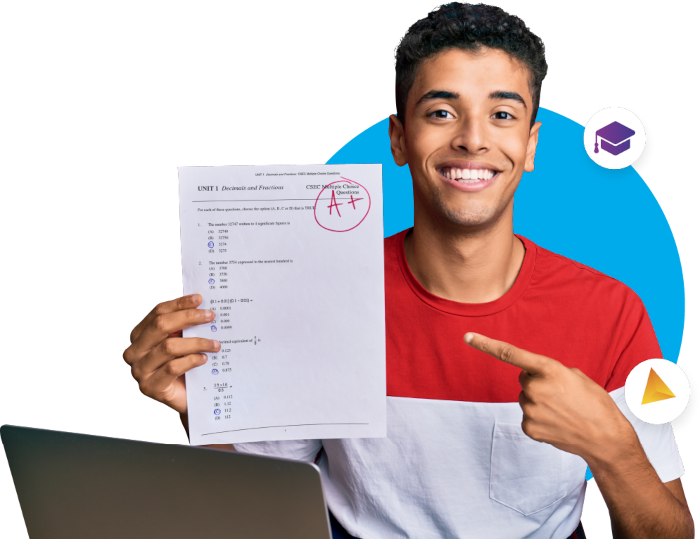Our premium, interactive, 1-on-1, academic math tutoring will equip your teen to turn their Geometry struggles into As and confidence.
Apply Now
Our premium, interactive, 1-on-1 academic math tutoring will equip your teen to turn their Geometry struggles into As and confidence.
Apply Now

Geometry is a very unique type of math.
It's different from all other types of math your child will see in middle school, high school or college.Most types of math deal with relationships between numbers and variables (for example - input and output of functions).
Geometry, at its foundation, deals with relationships between angles, lines and polygons, as well as properties and characteristics of 2D and 3D shapes. The primary skill your child needs to succeed in Geometry is analyzing and interpreting diagrams.
See, in Algebra 1, your child solved problems that presented the algebraic equations or expressions. In geometry, your child needs to form them based on the diagrams. The algebraic solving is only the final part of each problem, and often relatively easy compared to the “heavy lifting” it takes to interpret the diagram and form an equation.
Apply Now

Geometry is a very unique type of math.
It's different from all other types of math your child will see in middle school, high school or college.Most types of math deal with relationships between numbers and variables (for example - input and output of functions).
Geometry, at its foundation, deals with relationships between angles, lines and polygons, as well as properties and characteristics of 2D and 3D shapes. The primary skill your child needs to succeed in Geometry is analyzing and interpreting diagrams.
See, in Algebra 1, your child solved problems that presented the algebraic equations or expressions. In geometry, your child needs to form them based on the diagrams. The algebraic solving is only the final part of each problem, and often relatively easy compared to the “heavy lifting” it takes to interpret the diagram and form an equation.
Apply Now

Here are the main challenges students experience in Geometry.
The skill of discernment
In other words knowing “how are diagrams A and B different and what does that tell me?” Many teachers simply present the formula, name the theorem and present an example. However, the biggest challenge in Geometry isn’t using the formula or understanding the theorem. It’s determining the relationship between the elements in the diagram. PIcking the theorem to use, out of all the available ones.
The skill of forming the equations from the diagram, relationship, theorem or context.
Many geometric shapes and diagrams have multiple elements, numbers, lines, angles and variables. Forming an equation requires your child to recognize which variable represents which element and how that fits into the equation.
Showing not teaching
Some teachers are great and some aren’t. But we’ve seen too many cases of teachers showing instead of teaching.
Showing an example is not enough to understand it. The key skill your child needs to learn to be successful in Geometry (and in the future math classes) is understanding how the elements relate.
It’s not about the “what”. It’s about the “how” and “why”. Seeing someone show you a solution is completely different from solving the problem yourself. Your child needs to learn how to take the steps required to solve problems proficiently. They need to understand how to make the decisions required to go from the diagram to the theorem to the equation to the solution.
Apply Now


Here are the main challenges students experience in Geometry.
The skill of discernment
In other words knowing “how are diagrams A and B different and what does that tell me?” Many teachers simply present the formula, name the theorem and present an example. However, the biggest challenge in Geometry isn’t using the formula or understanding the theorem. It’s determining the relationship between the elements in the diagram. PIcking the theorem to use, out of all the available ones.
The skill of forming the equations from the diagram, relationship, theorem or context.
Many geometric shapes and diagrams have multiple elements, numbers, lines, angles and variables. Forming an equation requires your child to recognize which variable represents which element and how that fits into the equation.
Showing not teaching
Some teachers are great and some aren’t. But we’ve seen too many cases of teachers showing instead of teaching.
Showing an example is not enough to understand it. The key skill your child needs to learn to be successful in Geometry (and in the future math classes) is understanding how the elements relate.
It’s not about the “what”. It’s about the “how” and “why”. Seeing someone show you a solution is completely different from solving the problem yourself. Your child needs to learn how to take the steps required to solve problems proficiently. They need to understand how to make the decisions required to go from the diagram to the theorem to the equation to the solution.
Apply Now
Geometry Challenges
We Will Help Your Teen Overcome.
Geometry Challenges
We Will Help Your Teen Overcome.
Low retention of Algebra 1 concepts
Your child has taken Algebra 1 more than 12 months ago. Many students have difficulty retaining details of the material covered 5-6 months before (that's why the finals are difficult). As you might expect, by the time Algebra 2 rolls around, your child may not remember much of Algebra 1.Hence, many students need an extensive review. Algebra 2 includes all Algebra 1 foundations but with additional context, advanced concepts, methods and steps so struggling with Algebra 1 really holds a lot of students back.
Big homework-test gap
Many students feel that they understand the concepts when they are explained in class and are able to solve a lot (or all) homework problems. Yet, they struggle on tests.Some students are able to score 100% on homework and still fail tests.
How is that possible?
The problems on the tests tend to be more complicated, with extra steps, different wording or different twists.
Apply Now


Low retention of Algebra 1 concepts
Your child has taken Algebra 1 more than 12 months ago. Many students have difficulty retaining details of the material covered 5-6 months before (that's why the finals are difficult). As you might expect, by the time Algebra 2 rolls around, your child may not remember much of Algebra 1.Hence, many students need an extensive review. Algebra 2 includes all Algebra 1 foundations but with additional context, advanced concepts, methods and steps so struggling with Algebra 1 really holds a lot of students back.
Big homework-test gap
Many students feel that they understand the concepts when they are explained in class and are able to solve a lot (or all) homework problems. Yet, they struggle on tests.Some students are able to score 100% on homework and still fail tests.
How is that possible?
The problems on the tests tend to be more complicated, with extra steps, different wording or different twists.
Apply Now

Not enough covered in class
In your child’s class, the teacher likely shows 3-5 problems and hands out homework. I can say that with certainty because we see this over and over, with vast majority of students we talk to. It's prevalent.Showing 3-5 problems is not nearly enough.
Every topic in Algebra 2 has from 3 to 7 problem types. For every problem type, your child will have to deal with several different cases.
Hence, it’s pretty clear that your child’s teacher isn’t teaching nearly enough for your child to understand all of the problem types.
And yes, of course, your child should do homework and practice on their own. But they can’t do that without first having a solid fundamental understanding of the new material.
Passive learning
In class, in most cases, students don’t solve problems. They simply copy the solutions from the white board or fill out the notes sheet.That's called passive learning. And passive learning doesn't work. Instead of watching the teacher solve problems, reading the textbook or watching videos online, your child needs to actively analyze and solve problems.
Apply Now

Not enough covered in class
In your child’s class, the teacher likely shows 3-5 problems and hands out homework. I can say that with certainty because we see this over and over, with vast majority of students we talk to. It's prevalent.Showing 3-5 problems is not nearly enough.
Every topic in Algebra 2 has from 3 to 7 problem types. For every problem type, your child will have to deal with several different cases.
Hence, it’s pretty clear that your child’s teacher isn’t teaching nearly enough for your child to understand all of the problem types.
And yes, of course, your child should do homework and practice on their own. But they can’t do that without first having a solid fundamental understanding of the new material.
Passive learning
In class, in most cases, students don’t solve problems. They simply copy the solutions from the white board or fill out the notes sheet.That's called passive learning. And passive learning doesn't work. Instead of watching the teacher solve problems, reading the textbook or watching videos online, your child needs to actively analyze and solve problems.
Apply Now
Lack of individualized attention
The teachers sometimes aren’t able to answer questions. Sometimes they don’t want to. But even if they do, it’s very difficult with 20-30 students in the class. And since questions are the building blocks of learning, your child misses out on a lot of progress. To reach their full potential, they should learn at their own pace, ask questions about what's confusing to them, focus on the problems types they need to work on and learn in accordance with their learning preferences.Homework doesn't help
Many parents don’t know this but teachers often check the homework for completion, not correctness...Which means that your child gets 100% as long as they did the problems, regardless of whether they solved them correctly or not.
Yes, that explains why many students get 100% as their homework grade and still do poorly on tests.
Apply Now


Lack of individualized attention
The teachers sometimes aren’t able to answer questions. Sometimes they don’t want to. But even if they do, it’s very difficult with 20-30 students in the class. And since questions are the building blocks of learning, your child misses out on a lot of progress. To reach their full potential, they should learn at their own pace, ask questions about what's confusing to them, focus on the problems types they need to work on and learn in accordance with their learning preferences.Homework doesn't help
Many parents don’t know this but teachers often check the homework for completion, not correctness...Which means that your child gets 100% as long as they did the problems, regardless of whether they solved them correctly or not.
Yes, that explains why many students get 100% as their homework grade and still do poorly on tests.
Apply Now
Concepts covered
in Geometry
- Congruence
- Parallel lines with a transversal
- Triangles
- Polygons - classifying, properties, differences
- Parallel and perpendicular lines
- Similarity and proportionality
- Proofs
- Transformations (translations, reflections, rotations, dilations, mixes)
- Euclidean geometry
- Distance, midpoint
- Centers of a triangle (orthocenter, incenter, circumcenter, centroid)
- Geometric probability
- Right triangles, pythagorean theorem and trigonometry
- Circles - sectors, arcs, angles, segments, tangents
- 3D solids - surface area, volume; 2D shapes - area, perimeter
- Regular polygons - apothem, perimeter, area
These concepts are covered in different order depending on the school, class and even specific teacher.
The depth and difficulty level also depends on variety of factors. That’s why we always customize the approach to every student’s individual needs.

We develop a personalized learning plan to fit your child's math class and goals.
Apply Now
Apply Now

Concepts covered
in Geometry
- Congruence
- Parallel lines with a transversal
- Triangles
- Polygons - classifying, properties, differences
- Parallel and perpendicular lines
- Similarity and proportionality
- Proofs
- Transformations (translations, reflections, rotations, dilations, mixes)
- Euclidean geometry
- Distance, midpoint
- Centers of a triangle (orthocenter, incenter, circumcenter, centroid)
- Geometric probability
- Right triangles, pythagorean theorem and trigonometry
- Circles - sectors, arcs, angles, segments, tangents
- 3D solids - surface area, volume; 2D shapes - area, perimeter
- Regular polygons - apothem, perimeter, area
These concepts are covered in different order depending on the school, class and even specific teacher.
The depth and difficulty level also depends on variety of factors. That’s why we always customize the approach to every student’s individual needs.
We will develop a personalized learning plan to fit your child's math class and goals.
Apply Now
Apply Now
Challenges students
experience on tests
“We didn’t do this in class.”
Sometimes the class runs short on time, there’s a sub or the teacher focuses on one of the problems, and there isn’t enough time to cover everything.When that happens, students often find themselves having to figure out the concepts, even the hardest ones, on their own.
“I kind of understand this problem but the wording throws me off.”
Teachers don’t cover many problems in class. As we mentioned, they usually show around 4-6 problems. Then, your child receives cookie-cutter homework.That creates a problem: during tests, students often encounter what we call "variations".
"Variations" are problems that often resemble the examples solved in class or in the homework but are different enough to be confusing. And students aren't sure how to approach them.
“These problems are way harder than homework.” Often times, the problems covered in class are easy to intermediate. There isn’t enough time to cover the hardest problems. But if your child is aiming for an A (or even a high B), they need to be able to solve all problems that show up on tests, especially the most challenging ones.
Challenges students
experience on tests
“We didn’t do this in class.”
Sometimes the class runs short on time, there’s a sub or the teacher focuses on one of the problems, and there isn’t enough time to cover everything.When that happens, students often find themselves having to figure out the concepts, even the hardest ones, on their own.
“I kind of understand this problem but the wording throws me off.”
Teachers don’t cover many problems in class. As we mentioned, they usually show around 4-6 problems. Then, your child receives cookie-cutter homework.That creates a problem: during tests, students often encounter what we call "variations".
"Variations" are problems that often resemble the examples solved in class or in the homework but are different enough to be confusing. And students aren't sure how to approach them.
“These problems are way harder than homework.” Often times, the problems covered in class are easy to intermediate. There isn’t enough time to cover the hardest problems. But if your child is aiming for an A (or even a high B), they need to be able to solve all problems that show up on tests, especially the most challenging ones.

Equip Your Teen To Excel In Geometry With Our Professional, Interactive, 1-on-1 Academic Math Tutoring.

